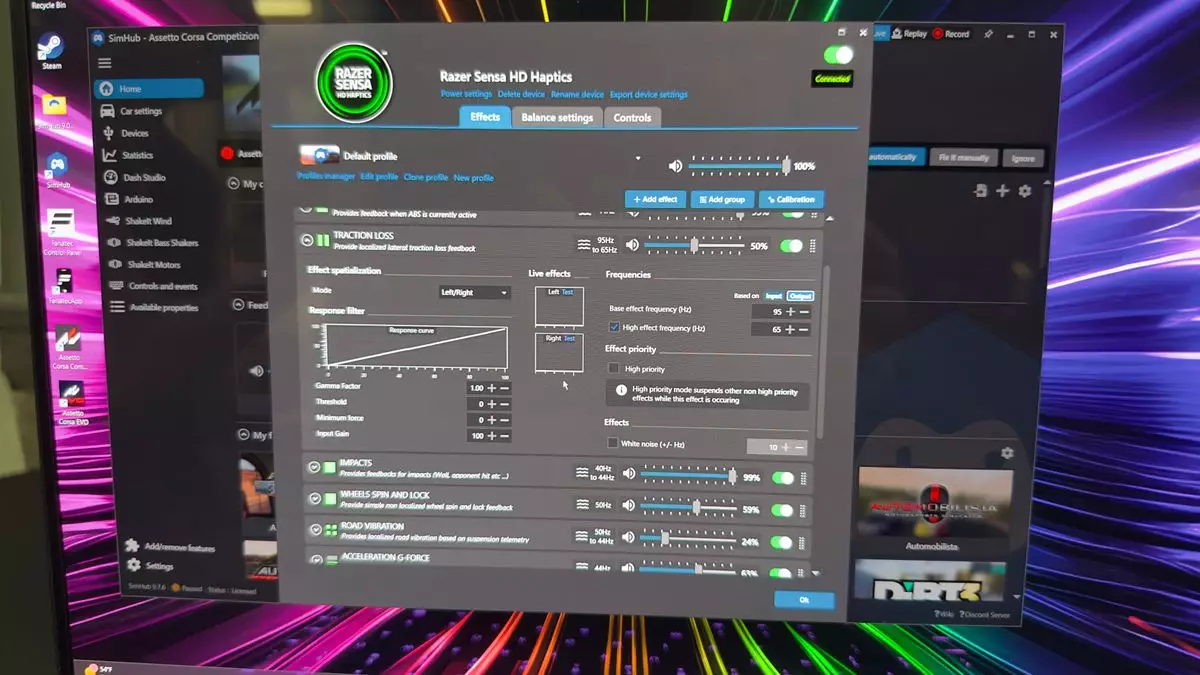In the ever-evolving gaming industry, the introduction of haptic feedback technology marks a significant advancement—especially for simulation racing enthusiasts. Razer’s latest offerings, namely the Freyja seat pad and the Kraken V4 Pro headset, epitomize this evolution. While the Kraken headset impresses with its audio fidelity, its hefty price can be daunting, creating a barrier for many casual gamers. In contrast, the real excitement lies in how these devices are utilized together, a facet fully realized in environments such as the Global Design Conference (GDC) 2025.
Having experienced the synergy of the Freyja and the Kraken at GDC, it becomes evident that this technology is tailored specifically for a devoted audience: sim racers. The combination provides players with enhanced immersion that transcends mere visual and auditory feedback. My own experience with games like Assetto Corsa Competizione revealed that the addition of tactile sensations dramatically altered my ability to perceive the game’s nuances.
Feeling the Game: A Revolution in Control
When I settled into the Freyja while donning the Kraken headset, the simulation world opened up. The first few minutes were a sensory overload; the vibrations coursing through the seat were novel but somewhat distracting. However, once I became accustomed to the feedback, the experience transformed. The way I sensed braking points and understeering became more intuitive. Coupled with the force feedback of a robust direct-drive setup, I was able to carve lap times more effectively.
The transition from auditory cues to haptic feedback allowed me to shed the conventional methods of racing. Instead of straining to listen for engine sounds indicating optimal throttle application, the haptic vibrations painted a clearer picture of my car’s behavior on the track. This newfound sensitivity to tactile feedback improved my racing strategy, underscoring the potential of Razer’s technology in enhancing competitive play.
The Future of Immersive Racing Equipment
The most intriguing question raised during my experience was whether Razer would develop a complete racing seat that houses the Freyja’s features. Razer’s ambiguous response hinted at something in the works, and it’s hard not to speculate on the possibilities. A racing seat fully integrated with haptic feedback technology could revolutionize the sim racing setup. Currently, the Freyja lacks lateral support, which compromises the immersive experience. In a well-designed racing bucket seat, simulated forces would enhance cornering sensations, providing even greater authenticity during gameplay.
However, such advancements come with challenges. Sim racing has carved out a passionate niche within the gaming universe, but the overall market remains somewhat small compared to broader gaming trends. Launching a premium product like a motion-enabled racing rig would likely translate to limited sales, a reality that could hinder widespread market acceptance. Pricing becomes a pivotal concern; the Freyja already sits at a high price point, leading to the possibility that an advanced racing seat could evolve into a luxury item, out of reach for the average consumer.
The Integration of Software and Hardware
In addition to hardware, Razer has shared exciting developments on the software front. The announcement of Wyvrn—a unifying software development kit—promises to elevate the gaming experience. Fully integrated into Unreal Engine 5.5, this SDK enables future racing titles to harness the full potential of Razer’s hardware, offering unprecedented connectivity between devices. This combined effort highlights a commitment to building an ecosystem where players can fully realize the possibilities of haptic feedback.
This integration underscores a growing trend in gaming—seamless collaboration between hardware and software. The anticipation around how Wyvrn will optimize gameplay is palpable. As more racing games develop on this engine, expectations will rise for what Razer’s technology can achieve in terms of immersion and engagement.
The Personal Touch: Living with Haptic Technology
Reflecting on my GDC experience, there is a bittersweet longing for the technology to enhance my gaming setup at home. The thoughts of my humble office vibrating like a mini earthquake while I race are amusing, but also a slight source of pause. Would my feline companions appreciate the unexpected rumblings of a racing simulator? Perhaps not. Still, the excitement for the potential of haptic feedback is undeniable, especially in how it can transform not just racing, but the broader gaming landscape.
Although not everyone may need or understand the intricacies of haptic technology, its potential to deepen immersion speaks to the future of gaming. Here’s hoping that Razer’s innovations will pave the way for an even more exhilarating and vibrant gaming experience in the months and years to come.

